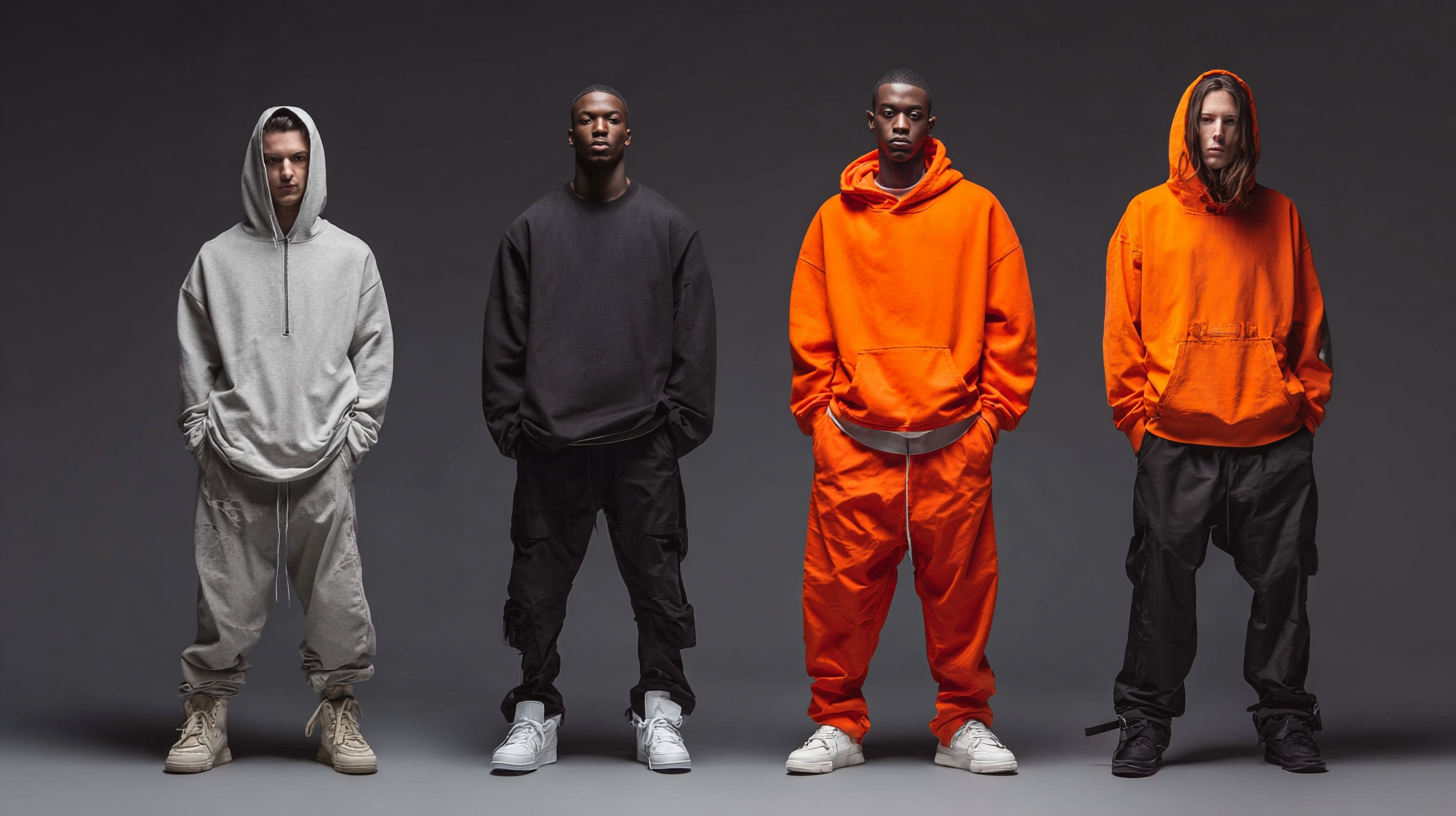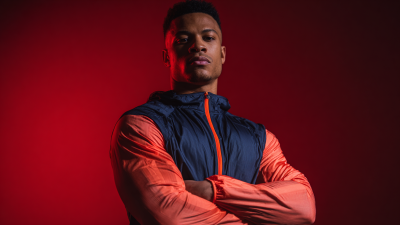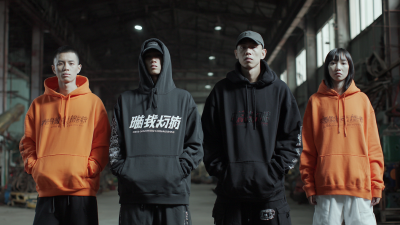
 The journey of men's tracksuits has transformed dramatically over the decades, evolving from mere athletic apparel into a staple of contemporary streetwear fashion. Originally designed for comfort and performance in sports settings, these versatile garments have transcended their practical roots to become a symbol of style and cultural significance. As fashion trends shift and blur the lines between casual and formal wear, men's tracksuits have adapted to capture the essence of modern urban life. This evolution reflects broader societal changes, with tracksuits now embodying both functionality and aesthetic appeal.
The journey of men's tracksuits has transformed dramatically over the decades, evolving from mere athletic apparel into a staple of contemporary streetwear fashion. Originally designed for comfort and performance in sports settings, these versatile garments have transcended their practical roots to become a symbol of style and cultural significance. As fashion trends shift and blur the lines between casual and formal wear, men's tracksuits have adapted to capture the essence of modern urban life. This evolution reflects broader societal changes, with tracksuits now embodying both functionality and aesthetic appeal.
This article aims to explore the dynamic trajectory of men's tracksuits, highlighting key influences and milestones that have shaped their current status in the world of fashion. By examining the interplay between sports and street style, we can better understand how men's tracksuits have firmly established themselves as an enduring wardrobe essential.
The historical roots of men’s tracksuits can be traced back to the early 20th century when athletes began to seek more comfortable and functional clothing for training and competition. The adoption of jersey fabric for athletic wear marked a significant progression, leading to the 1960s when tracksuits gained traction within the sporting community. This transformation coincided with emerging trends in sports marketing and sponsorship, a report from the Sports & Fitness Industry Association (SFIA) noted that activewear sales grew by 3.6% in the U.S. alone in 2020, showcasing a clear shift towards athleisure and tracksuits as essential athletic apparel.
As the decades progressed, particularly in the 1980s, tracksuits began infiltrating street culture, supported by the rise of hip-hop and urban fashion. Influential figures in music and film, such as Run-D.M.C. and the popularity of brands like Adidas, propelled tracksuits into the limelight. A report from Statista published in 2021 indicates that the global sports apparel market, which includes tracksuits, was valued at approximately $167 billion and is anticipated to reach around $248 billion by 2026. This growth signals not just a trend but an evolution of men’s tracksuits from their practical origins to a staple in contemporary streetwear fashion, reflecting a broader cultural shift that embraces comfort and personal expression alongside athletic performance.
The transformation of men's tracksuits from mere athletic gear to a prominent style statement illustrates a significant shift in fashion dynamics. Originally designed to enhance performance and provide comfort during workouts, tracksuits were primarily associated with the realm of sports. Their functional materials and sporty silhouettes catered to athletes and fitness enthusiasts, allowing for ease of movement and practicality. Over time, however, these utilitarian pieces began to permeate popular culture, fueled by the rise of streetwear and urban fashion trends.
As tracksuits made their way off the track and into the streets, they evolved in both design and perception. High-profile endorsements by celebrities and influencers turned tracksuits into symbols of casual coolness, bridging the gap between comfort and style. Fashion designers embraced this trend, reimagining traditional tracksuit aesthetics with luxurious fabrics, bold patterns, and innovative cuts. This transition from functionality to fashionable statement signifies a broader cultural acceptance of athleisure, highlighting how daily wear can seamlessly blend sportiness with aesthetic appeal, challenging conventional notions of dress and redefining masculinity in the process.
This chart illustrates the shifting purpose of men's tracksuits over the decades, highlighting the transition from athletic wear to a streetwear fashion statement. The data represents the popularity of tracksuits in different contexts from the 1980s to the present.
The tracksuit has undergone a remarkable transformation, moving from its origins in sports to becoming a staple of streetwear fashion. This evolution owes much to various cultural icons who embraced the tracksuit, elevating it from mere athletic wear to a symbol of style and identity. Figures like David Beckham, known for his effortless blend of sporty and chic, played a crucial role in popularizing the tracksuit beyond the gym. His appearances in tailored versions of this ensemble on and off the field showcased how versatile and fashionable these garments can be.
In addition to Beckham, hip-hop artists in the 1980s and 1990s significantly influenced tracksuit trends. Artists like Run-D.M.C. donned tracksuits as part of their signature looks, imbuing the clothing with a sense of authority and coolness that resonated with fans. Their cultural impact helped to shift the perception of tracksuits from something purely functional to a statement piece in everyday fashion. This trend continued into the 2000s and beyond, with celebrities such as Kanye West and Rihanna further blurring the lines between casual wear and high fashion, solidifying the tracksuit's status as a versatile and stylish option for people across various walks of life.

The evolution of men's tracksuits showcases a significant transformation from purely functional sportswear to a staple of streetwear fashion. With the global athletic apparel market projected to grow from $220.3 billion in 2025 to $298.0 billion by 2032, the demand for versatile and stylish designs has driven brands to innovate and adapt. This transition highlights a keen focus on materials, styles, and branding that resonates with modern consumers who value both performance and aesthetics.
Recent trends indicate a shift towards sustainable materials in athletic apparel, reflecting a growing consumer preference for eco-friendly products. As the fitness and athleisure markets expand, brands are responding by introducing tracksuits made with sustainable fabrics that not only enhance performance but also reduce environmental impact. Furthermore, the projected growth of the plus-size clothing market, which is expected to see substantial increases by 2032, suggests a widening inclusivity in design that encourages all body types to embrace sporty styles without compromising on fashion. This evolution is not just about clothing but also about creating a lifestyle that merges function with form, appealing to a diverse range of consumers.

The integration of tracksuits into everyday wardrobes has marked a significant shift in fashion, seamlessly blending sport with streetwear. According to a report by Grand View Research, the global athleisure market size was valued at approximately $300 billion in 2020 and is expected to grow at a compound annual growth rate (CAGR) of 8.1% from 2021 to 2028. This booming interest in athleisure reflects a broader cultural trend where comfort meets style, encouraging fashion enthusiasts to embrace sportswear not only in the gym but also in daily settings.
Today’s tracksuits are no longer confined to athletic events; they have transitioned into versatile pieces that can be dressed up or down. Influencers and celebrities are frequently spotted pairing sleek tracksuits with high-end accessories, illustrating how traditional sportswear can elevate casual outings. According to a survey conducted by the NPD Group, 44% of consumers stated they wear athleisure outside of the gym at least once a week, further emphasizing the tracksuit’s newfound status as a staple in contemporary streetwear. Mixing tracksuits with tailored outerwear or stylish sneakers allows individuals to create unique looks, proving that the fusion of sport and streetwear is both practical and fashionable.
| Decade | Key Characteristics | Cultural Influence | Current Trends |
|---|---|---|---|
| 1970s | Bright colors, polyester material, often with stripes | Rise of athleticism and sports culture | Retro styles making a comeback |
| 1980s | Loose fit, bold patterns, emphasis on brand logos | Hip-hop culture and rise of breakdancing | Athleisure and oversized fits |
| 1990s | Baggy styles, graphic prints, streetwear influences | Grunge, hip-hop, and skate culture | Mixed fabrics and eclectic styling |
| 2000s | Slimmer fits, cargo styles, and improved fabrics | Pop culture influence from music and TV | Stylish sportswear collaborations |
| 2010s | Tailored cuts, mix of high and low-end brands | Street style, social media influence | Customizable tracksuits and unique prints |
| 2020s | Sustainable materials, relaxed fits, bold colors | Focus on eco-conscious fashion and diversity | Hybrid styles combining sport and leisure |






